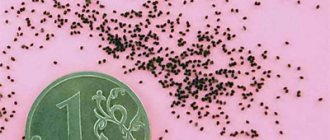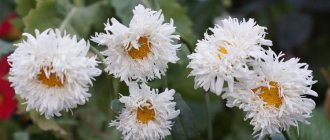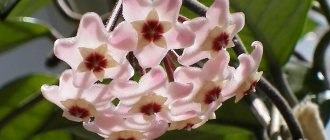More recently, just 20 years ago, this plant was classified as a member of the Petunia genus, but after a new systematization in 2005, a different DNA structure was discovered in it, after which calibrachoa was identified by botanists as a separate series. Unlike petunia, which has only 14 chromosomes, the calibrachoa flower has as many as 18. But to distinguish them, you don’t have to look so deep; you can even distinguish them from a photo. The same bell flowers, but smaller, completely covering the spherical bush. They also have other differences, which will be discussed below. Growing and caring for calibrachoa at home is not burdensome, and the bush looks very decorative. Therefore, amateur flower growers have every reason to pay close attention to this luxurious flower. Only growing calibrachoa from seeds can cause some difficulties, but this issue is not as complicated as it seems.
General description with photo
Calibrachoa is related to the Solanaceae genus. Its stem shoots become woody and become strong and rigid, especially in the root part. Young stems that have not yet become lignified hang down as they grow, due to which the plant takes on an ampelous shape. The bud has a “throat” that is colored differently than the petals. It is usually brown or yellow in color. The inflorescence of the plant in the basic version is simple, but breeders have already bred terry hybrids. However, in terms of the number of blossoming buds, they still lose to the “simple varieties”.
How to distinguish calibrachoa from petunia
Often you have to identify the differences between these two plants yourself, since there is often confusion on sale. Garden centers can call Calibrachoa seedlings anything they like, such as ampelous petunia or, more commonly, surfinia. This is not done for the purpose of deception, but because of the focus on the consumer, who is much more familiar and understands these names. To accurately determine the name of a culture, pay attention to the following signs:
- Inflorescence size. In the vast majority of petunias it is much larger, but in calibrachoa they usually do not exceed 3 cm in diameter. The exception is the Shock Wave mini petunia, which also has small buds.
- Pharynx color. In Calibrachoa, the “throat” of the flower has a contrasting color, most often bright yellow. In petunias it does not stand out in color.
- Leaves. In Calibrachoa they are noticeably narrower (no more than 1 cm) and have a more elongated shape, and in addition, are covered with short pubescence.
- Stems. If in petunia they are bare and flexible, of the herbaceous type, then in calibrachoa they are woody, like in shrub plants, and may have short pubescence, like on leaf blades.
The second name of the plant is “million bells” (there is also a variety of the same name). There really are a lot of flowers on it, especially considering the considerable length of the hanging shoots from the pots.
Requirements for soil and planting site
Although calibrachoa has smaller flowers than petunia, it is no less decorative and easier to grow. The calibrachoa flower, due to its origin (a plant native to rocky areas), is more resistant to adverse conditions than petunias. It grows well and blooms profusely in a sunny or well-lit location, but can also be grown in light partial shade.
Calibrachoa prefers a fertile, permeable substrate with an acidic to slightly acidic pH (5-5.5 pH), but will also cope with regular flower soil. Like petunia, it requires a constantly moist substrate, but it tolerates the vagaries of the weather better (rain, wind, heat, temperature fluctuations). The flower should be sown in pots with good water flow and drainage; the roots are quite sensitive to waterlogging and may suffer from fungal diseases that cause root rot.
It is worth adding a little sand to the substrate for sowing calibrachoa seeds and mixing. Sand will increase oxygen access to the roots. This way we will avoid rotting of the root system.
In flower shops you can find new varieties that better tolerate excess water and are less likely to suffer from diseases:
- Calita group;
- varieties from the Superbells group.
The big advantage of calibrachoa is its relative resistance to powdery mildew.
Photo. Calibrachoa looks great in balcony boxes, as well as in all kinds of hanging baskets.
The best varieties and hybrids with photos
Of the many varieties of calibrachoa, a significant part of them can be adapted for cultivation in the middle latitudes of Russia, but, of course, without wintering outside. Let's look at the best varieties and hybrids.
"Kablum blue"
Grown in hanging flowerpots, garden arbors, supporting walls, etc. as a pilot. Our flower growers were one of the first to recognize this variety (more precisely, a group of varieties). Produces shoots of medium length, usually not exceeding 0.5 m. The buds are blue-violet in color with a yellow “eye” of a characteristic rectangular shape, miniature. Unlike seed material of other varieties, it is better not to treat these seeds with growth stimulants, especially since they already show good germination and vegetative activity. For faster germination, a short soaking in plain water is sufficient.
"A Million Bells"
This varietal series includes almost two dozen varieties, painted in a variety of colors - snow-white-pink, lavender-purple, burgundy-red and yellow. Most often found on sale and in home collections are lilac, lilac and violet shades with lighter edges of the petals. They produce long shoots, up to a meter or more, and fully justify their name with an abundance of color.
Popular hybrids and variety series
- Kabloom - from snow-white and light pink to raspberry color. One of the earliest and most popular varieties is Kabloom Blue, which blooms in a dark purple palette.
- Crave - very interesting in this series are the Strawberry Star hybrid, which has a two-tone color in the shape of a crimson star on a white field, and the Crave Sunset hybrid, painted with a mesh of a dark brick tone on a bright orange background. It should be noted that new varieties of "Crave" appear more frequently than the more famous "Kabloom". Apparently, breeders are now intensively working on this particular hybrid line.
Pests
Calibrachoa can be attacked by pests such as:
- thrips;
- whitefly;
- aphid;
- spider mite
If pests are detected, you will need to use insecticides: “Aktara”, “Aktellik”, “Fitoverm” or “Sunmite”. It is recommended to treat ticks 2 or 3 times with an interval of 7 days.
Growing Calibrachoa from Seeds
Until recently, Russian flower growers could purchase or independently obtain calibrachoa planting material exclusively in the form of cuttings or ready-made seedlings. However, since 2015, seeds grown and supplied from Holland began to enter the Russian market. This made it easier and greatly expanded the choice of varieties of interest, however, it added a lot of trouble, since growing calibrachoa from seeds at home is quite a troublesome task.
Let's list the main steps that will help you get the desired result.
- The granules are placed on moist soil (it is best if they are peat tablets) and pressed to a shallow depth. It is not recommended to deepen them too much. They are lightly sprinkled with soil on top and the planting is compacted.
- Watering is carried out using a spray bottle or through paper. The soil must first be well moistened, and the peat tablet must be completely softened. It is best to soak it in boiling water. And then cool completely.
- The container is covered with a film in which slits are made in places for air circulation while maintaining heat and high humidity (greenhouse conditions).
- The container should be in a well-lit place, but not in the open sun. Moreover, you should avoid direct sunlight not only at midday.
- It is necessary to maintain moderate soil moisture, avoiding drying out or stagnant waterlogging. If the soil dries out, the seeds will die very quickly. To do this, watering is carried out often and little by little, up to 3 times a day.
- As soon as the first shoots appear, you need to change the watering regime downward, making it moderate.
- You can expect active growth and expansion of green and root mass after 3-4 weeks.
- Picking is done 1.5 months after planting. By this time, the first rudiments of branching of the shoots should become noticeable.
- Once the temperature is at least +22C, the seedlings should begin to be taken outside and hardened off. With the onset of warm nights, the flower pots can be left outside overnight.
- Calibrachoa seeds take quite a long time to germinate, and during this time constant care is required for planting.
The germination rate of the seeds of this plant is estimated by the manufacturer as quite high - up to 80%. But in reality it is much lower, so planting should be done with a margin.
When to plant calibrachoa seeds?
The best sowing time will be February, the first half of the month. It's better to finish it anyway
until the beginning of spring. In this regard, you should not rely on petunia, since it has larger and faster germinating seeds. Calibrachoa seedlings grow more slowly, which requires earlier planting.
Why can’t you plant calibrachoa with self-collected seeds?
The result of planting a flower with homemade seeds usually leaves much to be desired. Parental characteristics are rarely inherited exactly; “children” grow up to be different from their parents. In addition, they may not bloom well, be too small and have a completely different color.
Soil mixture and seedling feeding
At the stage of growing from seeds, calibrachoa especially needs a nutritious, high-quality substrate. To obtain it, you need to add high-moor peat, a little compost and, if the soil is dense enough, a little sand to give it looseness to ordinary garden soil. If the soil reaction is acidic, a small amount of lime or ash should also be added to it. A drainage layer must be laid at the bottom of the container, for which small river pebbles are ideal, then a layer of sand is poured, and after that the rest of the earth is laid.
Before planting, fertilize the soil mixture with a mineral complex. In the future, it is advisable to feed the seedlings every 2 weeks, combining feeding with watering. Recommended compositions: potassium-phosphorus complexes, nitrophoska, ready-made mineral complexes for flowering crops or just compost. Some of them are applied to the soil by spraying according to the manufacturer's instructions.
Do not use fresh organic matter such as manure or bird droppings to feed calibrachoa; this can cause the development of fungal diseases, to which the plant is not very resistant.
Planting calibrachoa from cuttings
If you have an adult specimen of the desired variety, it is much easier to propagate the flower through vegetative cuttings. The apical cuttings are cut in September to approximately 4-5 cm in length. The lower leaves need to be removed from them, and then stuck into loose, moist soil. For successful rooting, it is necessary to create a moist, warm environment, which can be easily achieved by daily moderate watering and covering with film or plastic. Once planted, Calibrachoa cuttings will be ready for the next warm season.
How to care for petunia in pots
Caring for ampelous petunias in pots involves proper watering, regular feeding (every seven to ten days) and pruning long shoots, but there are other important points.
- You cannot feed crops with fresh manure; it is better to use mineral complexes for petunias.
- It is not recommended to apply fertilizers in winter.
- It is necessary to prevent stagnation of water in the pot or tray.
- Watering should be done only at the root and in no case from a hose.
- On rainy and windy days, or during a thunderstorm, petunia flowers may be damaged, so it is better to place them in a shelter for a while.
- With the arrival of autumn cold weather, petunias stop flowering outdoors, but indoors they will continue to bloom. Plants can be brought into the house.
Diseases and infections
The main problem when growing seedlings is the blackleg disease. It is extremely difficult to fight this infection in seedlings; it is better to dispose of diseased specimens immediately. You should especially carefully monitor this when adjacent to tomato seedlings - plants easily become infected from each other.
A good preventative measure against root rot and other infections is disinfecting the soil mixture, especially if it is taken from a garden plot. This can be done by calcination, pouring boiling water or manganese solution, as well as temporary freezing.
If the leaves of a plant turn pale, it weakens before our eyes, we can talk about chlorosis. In this case, you need to reduce watering and urgently treat the specimen with iron chelate.
Transplanting ampelous petunia to a permanent place, timing
Transplantation of young plants should be done on a cloudy day or during a cool time of day. The soil is first moistened abundantly, the seedlings are removed along with a lump of earth, planted and watered again.
After hardening procedures, strong and strong seedlings of ampelous petunia are transplanted to a permanent place between the twentieth of May and the tenth of June, depending on the climate of the area.
It is very important that there are no longer sub-zero temperatures at night
Where is it better to plant: choosing flowerpots and flowerpots
When choosing a flower container for ampelous petunia, the following nuances must be taken into account:
- one plant requires three to five liters of soil;
- if a flowerpot or flowerpot will be located outdoors, then it must be made of durable material, because it will be exposed to strong winds or heavy rain;
- floor, wall and hanging containers must have drainage holes and trays;
- When planting a mini-flower garden, you need to purchase large pots, with a volume of fifteen to twenty liters.
How many petunias can be planted in one pot?
The number of seedlings in one flower pot depends on its size. For example, three plants can be planted in a container with a diameter of twenty to thirty centimeters, and up to five plants in a container with a diameter of forty centimeters.
What flowers can you combine petunia with in one pot?
Petunia ampelous and lobelia
Ampelous petunia, calibrachoa and pelargonium
Petunia gets along well and looks great in the same pot with bush petunia and lobelia. White fragrant alyssum, ageratum, calendula, marigolds, pelargonium and verbena will be an excellent companion.
Ampelous petunia, lobelia and verbena











